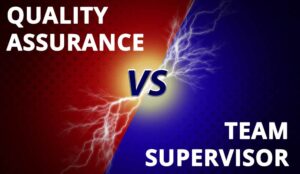Charlotte Ward of EvaluAgent shares how insights from your quality assurance (QA) programme can improve your contact centre coaching.
Giving feedback is something that almost all leaders still find a stressful experience, yet it’s a key part of the duties of anyone with direct reports.
For your customer service to be world-class, you can’t just rely on the usual ‘go-to’ of quarterly or half-yearly reviews.
Consistent and regular feedback cycles (of both positive and negative content) are key to the success of your service AND your team.
Why is Feedback so Hard?
Why do leaders find delivering feedback so traumatic? Why put it off till the annual review, then struggle to give any really worthwhile, actionable and relevant assessment of performance and skills?
Part of the issue here is a lack of process and support for the leader. Without the context of a tool, or procedural support, managers are nervous to deliver feedback, particularly feedback that might suggest improvement is necessary. The lack of a feedback process feeds into the perception that feedback might be taken personally, and thereby damage their relationship with the employee.
For some leaders, dealing with the potential anger, frustration, tears or embarrassment is just not worth opening that impromptu can of worms.
Should You Put it Off?
Is it really so harmful, though, to wait to the annual review, when you can just fill out that form with some recommendations and get it signed off, with any luck, before Christmas?
Yes. It really is.
In fact, waiting till the end of the year to give feedback, whether positive or negative, can be hugely detrimental to your team’s morale. Relevancy is lost, and, let’s face it, no-one’s memory is so infallible as to recall all the datapoints from the last 6-12 months that might provide context and thereby really actionable suggestions.
Performance issues that are highlighted only at review time, can fester for eleven months, and then pull the rug from under your employee’s feet.
Employees crave feedback, certainly, and in a fast moving customer support environment you just can’t afford to wait a year before providing guidance.
In fact, some 80% of younger employees actively prefer real-time feedback to annual reviews. Real-time, or very regular performance assessments are critical in maintaining morale, and improving communications patterns across the board, and forms the basis for a good coaching practice.
Regular feedback has the added benefit, too, of making the formal review processes much simpler. Most of the legwork is done through a cycle of ongoing documentation, and the review becomes just that, a quick review of the year.
And, of course, problems don’t linger. Issues are found and acted on in-the-moment.
Implementing a culture of regular feedback, and adopting the tools to support it, can propel your service quality and employee skill levels. A robust approach to in-the-moment, personalised coaching can prove more beneficial than generic, periodic training and retraining.
4 Benefits of Regular Coaching
Ongoing coaching gives you the opportunity to smooth out bumps in communication, set clear expectations, build skills, and help you keep your employees motivated and engaged.
1. Improved Communication
Let’s think about that typical review cycle again. Leaders avoid giving feedback to their agents until December or January, and then schedule an hour to push all the information at them in one go, generally expecting them to take it on board, sign off on the feedback, and go away to action it. It’s often overwhelming for the recipient.
The information might seem irrelevant or dated, or worse still, untrustworthy. This communication pattern can erode the trust in leadership, and build distance in the relationship that reduces its working effectiveness.
In a customer support team, a good Quality Assurance process can be an integral part of your coaching strategies.
A good QA platform supports your ability, as a leader, to monitor, and provide real-time or near real-time feedback and training to your staff.
Some of this can be semi-automated, using the platform to objectively measure, store and communicate the assessment. Or, you can use the platform as an opportunity to increase your in-person conversations.
2. Setting Expectations
If you’re not communicating regularly, the chances are that you’re not communicating clearly enough, either. Perhaps you haven’t provided any training since onboarding this agent? Maybe you do the odd bi-annual mailshot when a procedure changes or some other initiative is kicked off.
It’s unrealistic to expect your staff to retain all the information necessary to perform to the highest standard for long periods of time without a real refresher. And if they do stray from your key competencies, how do you bring them back on track without a clearly defined and referenced set of expectations?
Quality Assurance gives you the chance to coach regularly and in-the-moment, allowing your leadership team to re-state those expectations, have them documented, and keep them objective. Everyone is on the same page, every day.
Coaching like this, based on recent and objective data, gives your employee the chance to continually improve and adjust, with your ongoing guidance. The coaching becomes progressive, rather than personal.
EvaluAgent – QA supports a coaching program for customer support
3. QA and Coaching Build Skills at High Speed
When it comes to being progressive, rather than personal, coaching focuses on the future in the same way that reviews focus on the past. Having clear and objective set standards, it’s obvious what the problem was. It doesn’t usually warrant a huge amount of analysis. The focus of the conversation becomes what should change in future, rather than about what has happened in the past.
Documenting agreed next steps as part of the process enables all parties to know what is happening next, and comes with the tacit understanding that another assessment might happen any day or hour in a high-volume QA programme.
4. Coaching Keeps Employees Engaged
Of course, frequent communication and a continual process of checking in (not micromanaging) with your employee build a stronger relationship and keeps them engaged.
Annual reviews, particularly poor ones, often have the effect of distancing your employees from their destiny. They retract from the leader delivering the news. This is partly a defence mechanism. Poorly delivered, infrequent feedback can feel like an attack.
There’s a reason we usually pair “feedback” and “deliver”. It’s portrayed to be a one-way street. Leaders deliver feedback, and expect the employee to deal with it.
Coaching conversations are different. They allow the employee and leader to partner on the journey of improvement. The conversation doesn’t end when the feedback is given. This is a two-way street, with a constant flow of traffic.
Allowing this open discussion to develop over time, through a coaching programme, supported by solid QA of the service, allows the employee to be engaged in their own journey. Information and ideas are taken on board much more readily, and agents feel empowered by that partnership.
Author: Robyn Coppell
Published On: 12th Mar 2020 - Last modified: 18th Feb 2022
Read more about - Guest Blogs, EvaluAgent















